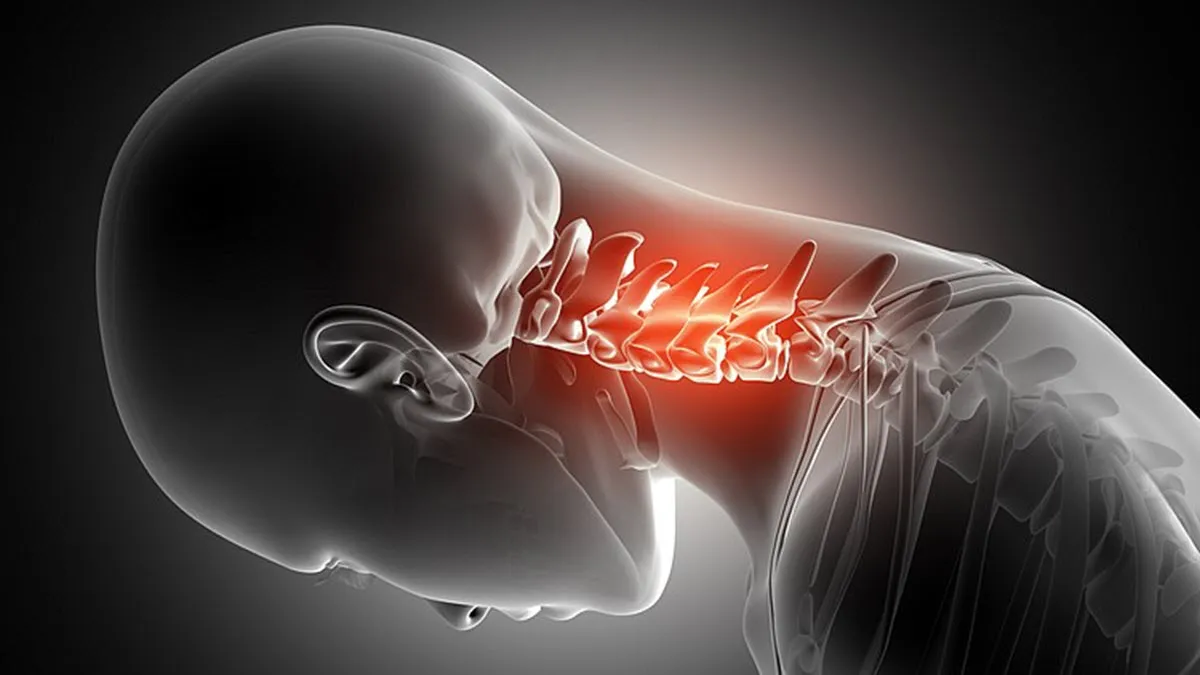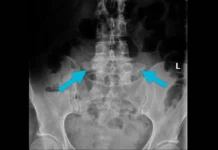Seven out of ten people will experience neck discomfort at some point in their lives. If you asked each of these people to describe their neck pain, you would probably get seven different stories.
Introduction
Neck pain is a common complaint that can result from a variety of causes. The symptoms associated with this pain can vary depending on the underlying source. Often, neck pain is characterized by a feeling of discomfort localized in the cervical region. This pain can be accompanied by stiffness, sometimes limiting neck mobility.
Headaches, particularly in the occipital region, are frequently associated with neck pain. It is not uncommon for the pain to radiate to the shoulders, arms or upper back. Feelings of numbness or tingling, as well as muscle weakness in the arms or shoulders, may also accompany neck pain.
Some individuals may experience increased sensitivity in the neck area, while others may experience noises such as crackling when moving. In rarer cases, coordination problems or bladder and bowel problems may occur, especially when the spinal cord is affected.
When experiencing persistent neck pain, it is essential to consult a healthcare professional for an accurate diagnosis and appropriate treatment plan.
causes of neck pain
- Muscle tension: Muscle tension resulting from poor posture, prolonged sitting in front of a computer screen, or trauma such as a false movement can cause neck pain.
- Cervical Arthritis: Cervical arthritis, also called cervical spondylosis, is an aging-related condition that causes the discs and joints of the neck to degenerate, causing pain and stiffness.
- Neck-related injuries: Car accidents, falls or direct impacts can cause injuries to the cervical vertebrae, intervertebral discs or ligaments of the neck.
- Herniated disc: A herniated disc in the cervical region can put pressure on the nerves, leading to neck pain and possibly symptoms radiating to the arms.
- Bad posture: Improper posture while sleeping, working, or other activities can lead to neck strain and pain.
- Cervicogenic headaches: Some headaches, such as tension headaches, can be linked to problems in the neck.
- Infections: Infections, although less common, can also cause neck pain. For example, an infection in the throat or lymph nodes in the neck area.
- Spinal Problems: Conditions such as spinal stenosis or birth defects can contribute to neck pain.
Symptoms of Neck Pain
- Local pain: A feeling of localized pain or discomfort in the neck area is the most obvious symptom.
- Stiffness: The neck may feel stiff, sometimes limiting range of motion.
- Headaches: Neck pain can often be accompanied by headaches, especially in the occipital region (at the back of the head).
- Radiation of pain: Pain may radiate to the shoulders, arms or upper back.
- Numbness or tingling: Some may experience numbness or tingling sensations in the neck area or upper extremities.
- Muscle weakness: Problems with nerves or muscles can lead to weakness in the arms or shoulders.
- Increased sensitivity: The neck area may be sensitive to touch.
- Crackles or clicks: Some may hear or feel noises such as crackles when moving their neck.
- Coordination Problems: In some cases, coordination problems may occur due to neck pain affecting the nerves.
- Bladder or bowel control: In very rare cases, when the spinal cord is compromised, bladder or bowel control problems may occur.
Ergonomic advice
Adjusting your work and sleep environment ergonomically can play a crucial role in preventing muscle strain and neck pain. Here are some tips for optimizing these environments:
Work environment tips:
- Height of desk and chair:
- Make sure your chair and desk are at the correct height. Your feet should touch the floor comfortably, and your elbows should be at about a 90-degree angle when using the keyboard.
- Sitting posture:
- Keep your back straight and supported by the back of the chair.
- Use a lumbar cushion if necessary to maintain the natural curve of your spine.
- Computer screen :
- Place your screen at eye level to avoid looking down or up for long periods of time.
- Make sure the distance between your eyes and the screen is comfortable.
- Break and stretching periods:
- Take regular breaks to stretch and change positions.
- Perform stretching exercises for your neck, shoulders and back.
- Ergonomic accessories:
- Use ergonomic accessories such as monitor stands, ergonomic keyboards and mice.
Sleep Environment Tips:
- Pillows and mattresses:
- Choose a pillow that maintains the natural curve of your neck.
- Opt for a mattress that provides adequate support for your spine.
- Sleeping position:
- Try sleeping on your back or side rather than your stomach.
- Use additional pillows to support areas that need it.
- Maintaining a neutral position:
- Avoid sleeping in positions that put excessive pressure on the neck and spine.
- Avoid uncomfortable accessories:
- Avoid using pillows that are too thick or too soft, which can misalign the spine.
- Dark and quiet room:
- Make sure your bedroom is conducive to sleep by dimming lights and minimizing noise.
- Maintain a regular sleep routine:
- Try going to bed and waking up at the same time every day to promote regular sleep.
- Avoid screens before bed:
- Limit the use of electronic devices before bed, as blue light can disrupt sleep.
Exercises to Relieve Neck Pain
It is important to note that if you experience persistent neck pain, it is always recommended to consult a healthcare professional before undertaking any exercises. That said, here are some movements and stretches that can help relieve neck pain and improve mobility:
- Lateral neck tilt:
- Sit or stand with your back straight.
- Gently tilt your head to the side, trying to bring your ear closer to your shoulder.
- Hold the position for 15-30 seconds.
- Repeat on the other side.
- Neck rotation:
- Sit or stand with your back straight.
- Slowly turn your head to one side, looking over your shoulder.
- Hold the position for 15-30 seconds.
- Repeat on the other side.
- Forward neck tilt:
- Sit or stand with your back straight.
- Gently tilt your head forward, trying to bring your chin closer to your chest.
- Hold the position for 15-30 seconds.
- Trapezius stretching:
- Sit or stand with your back straight.
- Lower one shoulder while tilting your head to the opposite side.
- Place your hand on the down side on your head and apply light pressure to increase the stretch.
- Hold the position for 15-30 seconds.
- Repeat on the other side.
- Shoulder rotation with neck stretch:
- Rotate your shoulders in a circle, then add a neck stretch by tilting your head to one side while rotating.
- Alternate sides to stretch the neck on both sides.
- Resistance exercise for the neck:
- Sit with your back straight and place your right hand on the right side of your head.
- Slowly tilt your head to the right while applying resistance with your hand to create tension in your neck muscles.
- Hold the resistance for a few seconds, then release.
- Repeat on the other side.
- Self-massage of the neck:
- Use your fingers to gently massage the neck muscles using circular motions.
- Focus on areas where you feel tension.
- Neck strengthening exercises:
- Tilt your head back and hold for a few seconds to strengthen your neck muscles.
- Tilt your head forward and resist with your hand to strengthen the anterior neck muscles.
It is crucial to proceed with caution and not force the movements. If pain persists or worsens, consult a healthcare professional. Additionally, if you have any pre-existing medical conditions, be sure to consult your doctor before undertaking any exercise program.
Neck pain prevention
Preventing neck pain often involves adjustments in daily habits, maintaining good posture, and adopting practices that promote cervical health. Here are some tips and practices that can help prevent muscle strain and neck problems:
- Maintain good posture:
- Avoid tilting your head forward or back for long periods of time.
- Make sure your computer screen is at eye level to avoid looking down for long periods of time.
- Workplace ergonomics:
- Adjust the height of your chair and desk to maintain a neutral posture.
- Use lumbar support to support the natural curve of your spine.
- Take regular breaks:
- Take breaks every hour to stretch and change positions.
- Do neck and shoulder stretching exercises during these breaks.
- Muscle strengthening exercises:
- Strengthen neck and shoulder muscles with appropriate exercises.
- Consult a healthcare professional.
- Use of cell phone:
- Hold your phone at eye level rather than tilting your head down.
- Avoid spending too much time texting or using your phone in an uncomfortable position.
- Pillows and mattresses:
- Choose a pillow that maintains the natural curve of your neck.
- Make sure your mattress provides adequate support.
- Stress management :
- Stress can contribute to muscle tension. Practice stress management techniques such as meditation, deep breathing, or yoga.
- Stretching exercises:
- Incorporate stretching exercises into your daily routine to maintain flexibility in your neck.
- Avoid prolonged positions:
- Avoid maintaining the same position for long periods of time, whether while working, driving, or watching television.
- Consult a healthcare professional:
- If you regularly experience neck pain, consult a healthcare professional for an accurate diagnosis and advice tailored to your situation.
Importance of posture
Correct posture plays a crucial role in maintaining neck health and overall well-being. Proper body position not only helps prevent neck pain, but it also promotes better muscle, joint, and even respiratory health. Here are some points highlighting the importance of maintaining good posture and practical tips to achieve it:
Impact of posture on neck health
- Spinal alignment: Correct posture keeps the spine in its natural alignment, reducing pressure on the intervertebral discs in the neck. This helps prevent muscle tension and pain.
- Reduction of muscle tension: Proper posture evenly distributes the weight of the body, thus avoiding overload on the neck muscles. This reduces the risk of stiffness and muscle tension.
- Joint support: Correct posture provides optimal support to the neck joints, reducing the risk of developing problems such as cervical arthritis.
- Headache Prevention: Poor posture can contribute to headaches, especially in the occipital region. Maintaining proper posture can help prevent these associated pains.
Tips for Maintaining Good Posture
- Body Awareness: Be aware of your posture throughout the day. Take a few moments to regularly assess your body position, whether you are sitting, standing or moving.
- Ergonomics at work: Adjust your workspace to promote correct posture. Use ergonomic chairs and position your computer screen at eye level.
- Strengthening exercises: Incorporate muscle-strengthening exercises into your routine, focusing on the muscles of your neck, shoulders and back. These exercises help maintain stability in the cervical region.
- Regular stretches: Perform neck and shoulder stretches to prevent stiffness. Gently tilt your head from side to side and back and forth to maintain flexibility.
- Sleeping position: Choose a pillow that supports the natural curvature of your neck when you sleep. Avoid pillows that are too high or too firm, which could compromise your neck position during the night.
- Physical Activity: Maintain a regular exercise routine that promotes strength, flexibility and overall balance. These elements help maintain healthy posture.
By following these tips and paying attention to your posture every day, you can significantly reduce the risk of neck pain and promote better long-term health.
Reference


























